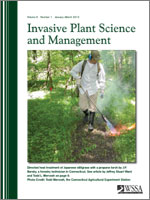Perennial pepperweed is an invasive plant that is expanding rapidly in several plant communities in the western United States. In California, perennial pepperweed has aggressively invaded seasonal wetlands, resulting in degradation of habitat quality. We evaluated the rate and dynamics of population spread, assessed the effect of disturbance on spread, and determined the biotic and abiotic factors influencing the likelihood of invasion. The study was conducted at eight sites within two wetland regions of California. Results indicate that in undisturbed sites, spread was almost exclusively through vegetative expansion, and the average rate of spread was 0.85 m yr−1 from the leading edge. Spread in sites that were disked was more than three times greater than in undisturbed sites. While smaller infestations increased at a faster rate compared with larger populations, larger infestations accumulated more newly infested areas than smaller infestations from year to year. Stem density was consistently higher in the center of the infestations, with about 2.4 times more stems per square meter compared with the leading edge at the perimeter of the population. The invasion by perennial pepperweed was positively correlated with increased water availability but was negatively correlated with the cover of perennial and annual species. Thus, high cover of resident vegetation can have a suppressive effect on the rate of invasion, even in wetland ecosystems. On the basis of these results, we recommend that resident plant cover not be disturbed, especially in wet areas adjacent to areas currently infested with perennial pepperweed. For infested areas, management efforts should be prioritized to focus on controlling satellite populations as well as the leading edge of larger infestations first. This strategy could reduce the need for costly active restoration efforts by maximizing the probability of successful re-establishment of resident vegetation from the adjacent seedbank.
Nomenclature: Perennial pepperweed, Lepidium latifolium L. LEPLA.
Management Implications: Perennial pepperweed is one of the most important invasive plants of wetland areas in the western United States. In several undisturbed plots at two locations, we showed that its spread was almost exclusively through vegetative expansion along the perimeter of the infestation at an average of 0.85 m yr−1. By comparison, the spread rate was three times greater in a site that was disked, which can explain why disking is not recommended for perennial pepperweed control. Stem densities were nearly 2.5 times higher in the interior of the infestations compared with the leading edge. Because of the reduced stem density, the perimeter of the patch is considered to be easier to control compared with the denser patch centers. Small infestations expanded at a faster rate compared with larger patches, but larger patches added more newly infested areas. We determined that the expansion of perennial pepperweed was more closely correlated with increased water availability but was negatively correlated with resident plant cover. Thus, we conclude that the most appropriate strategy for managing perennial pepperweed is to minimize disturbance of plant cover and control both the rapidly expanding satellite infestations and the perimeter of larger infestations. Concentrating management efforts on the densely stemmed, more difficult to control, and highly thatched regions at the center of the infestation might not be cost effective. These areas also have less resident vegetation. Furthermore, the ability of desirable resident vegetation to re-establish from the adjacent seedbank at the perimeter of the infestation could also prevent the need for expensive active restoration programs when focusing on the center of large infestations.





